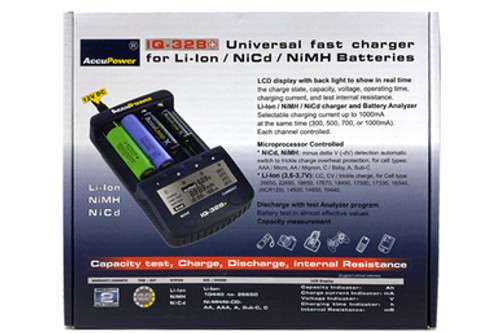
-

Battery Tester for AA / AAA / C / D Batteries
$7.99As low as:- Buy in bulk and save
Bulk discount rates
Below are the available bulk discount rates for each individual item when you purchase a certain amount
- Buy 2 - 5 and pay only $7.99 each
- Buy 6 - 99 and pay only $7.19 each
- Buy 100 or above and pay only $7.19 each
-

-

-

-

-

Batteries power many of the devices we rely on daily, from remote controls to power tools. However, when batteries fail unexpectedly, it can disrupt our day and lead to unnecessary frustration. To prevent this, testing and maintaining your batteries regularly is crucial, and battery testers are the ideal tool for the job.
Battery testers are devices designed to evaluate the voltage and overall health of a battery. They help you determine whether a battery needs recharging, replacement, or is still in good condition. By using a battery tester, you can avoid surprises and ensure your batteries and devices operate efficiently.
Types of Battery Testers
Battery testers come in a variety of designs, each suited to specific needs and battery types. Understanding the different options can help you choose the right tester for your needs.
1. Analog Battery Testers
Features:
Analog testers use a needle and scale to display the voltage of a battery. They are simple, cost-effective, and reliable for basic testing.
Best For:
Basic battery types like Alkaline, Zinc-Carbon, or small household batteries.
2. Digital Battery Testers
Features:
Digital testers feature a screen that displays the battery's voltage and other metrics, such as capacity or charge status. They provide more precise readings compared to analog testers.
Best For:
A wide range of battery chemistries, including Lithium, NiMH, and NiCd.
3. Multi-Battery Testers
Features:
These versatile testers can evaluate multiple battery types and sizes, including AA, AAA, C, D, 9V, and button cells. Some models can even test rechargeable and non-rechargeable batteries.
Best For:
Users who manage various battery types and sizes.
4. Specialized Battery Testers
Features:
Designed for specific battery chemistries or applications, such as Lithium-ion or automotive batteries. They provide detailed insights tailored to the battery type.
Best For:
Specialized batteries or professional use, such as in industrial or automotive settings.
How to Use a Battery Tester
Testing a battery is straightforward and can save you time and effort. Follow these steps to ensure accurate readings:
Choose the Right Tester
Ensure the battery tester is compatible with the type and size of the battery you want to test.
Insert the Battery
Place the battery into the tester, aligning it with the positive (+) and negative (-) terminals as indicated.
Turn on the Tester
Activate the tester. Analog models will display the reading on a scale, while digital models will show the results on a screen.
Evaluate the Reading
Compare the voltage displayed against the recommended voltage for your battery type.
For example, a standard AA Alkaline battery typically has a voltage of 1.5V when fully charged.
Decide the Next Step
If the voltage is close to the recommended value, the battery is in good condition.
If the voltage is significantly lower, the battery may need to be charged or replaced.
Test Other Batteries
Repeat the process for other batteries to ensure all are in good condition.
Benefits of Using a Battery Tester
Prevent Unexpected Failures
Regular testing ensures you know the condition of your batteries, preventing failures when you need your devices the most.
Save Money
By identifying usable batteries, you can avoid replacing batteries unnecessarily, reducing waste and saving money.
Optimize Performance
Testing helps you ensure your batteries are operating at peak performance, extending their lifespan.
Diagnose Device Issues
A battery tester can help you determine whether a device malfunction is due to the battery or another issue.
Eco-Friendly Practice
Properly testing batteries before discarding them reduces waste and supports environmentally friendly habits.
How to Maintain Your Batteries
In addition to testing, proper maintenance is crucial for extending the life of your batteries and ensuring they perform optimally.
1. Store Batteries Correctly
Keep batteries in a cool, dry place, away from direct sunlight and heat sources.
Avoid storing batteries in extremely cold or humid conditions, as these can reduce their lifespan.
2. Use the Right Charger
Ensure you use a charger compatible with the battery type, chemistry, and size.
Overcharging can damage batteries and shorten their lifespan.
3. Avoid Overcharging
Unplug chargers once batteries are fully charged to prevent damage.
4. Regular Usage
Use your batteries regularly to keep them active. Batteries left unused for long periods may lose their charge and capacity over time.
5. Proper Disposal
Recycle old or damaged batteries at designated recycling centers. Many communities offer programs for safe battery disposal.
Choosing the Right Battery Tester
When selecting a battery tester, consider the following factors:
Battery Types
Determine the types of batteries you use most frequently (e.g., AA, AAA, Lithium, NiMH).
Features
Decide if you need basic voltage testing or advanced features like capacity measurement or multi-battery compatibility.
Ease of Use
Choose a tester with a clear display and straightforward operation.
Portability
For on-the-go testing, consider a compact and lightweight model.
Durability
Invest in a tester made from high-quality materials for long-term reliability.
Battery testers are an essential tool for anyone who relies on batteries regularly. They help you monitor the health and performance of your batteries, allowing you to determine when they need charging, replacement, or recycling. With proper testing and maintenance, you can extend the lifespan of your batteries, save money, and ensure your devices are always ready for use.
Explore a wide range of battery testers at OnlyBatteries.com to find the perfect tool for your needs. From basic analog testers to advanced digital models, we have the right solution to keep your batteries and devices performing at their best.





